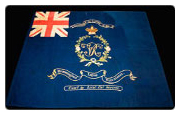It’s all in the details
September 25, 2012
Look up “painstaking” on the online Oxford English Dictionary and you’ll find this: “Done with or employing great care and thoroughness.” The words could have been written to describe how Canadian Museum of Civilization textile conservator Julie Hughes recently restored a remarkable flag commemorating battles in the Lower Canada Rebellion of 1837–1838.
The flag is a “regimental colour” made for the Hemmingford Loyal Volunteers, a militia unit raised to fight alongside British government troops during the armed conflict against the rebels of Lower Canada (now southern Quebec). On May 9, 1839, the ladies of Hemmingford presented the silk colours to the unit to commemorate its successful engagement with Patriote forces at the battles of Lacolle and Odelltown on November 7–9, 1838. It is one of the first surviving flags to include the monogram of the young Queen Victoria, on the throne for only two years in 1839. It was in poor shape when the Hemmingford Historical Society donated it to the Canadian War Museum in 2003.
“There were many areas of loss in the flag, and the ‘fly’ end – the free end farthest from the staff – was largely missing,” she explains. “However, the remaining silk was brittle but not powdery, and the flag had been stitched onto netting to keep all of the remnants in place.”
The first step was to remove the flag from the netting and then remove creases by gently humidifying the silk. Next a display mount was prepared – a rigid board, padded with backing fabric, dyed the same colour as the flag and stitched onto where the flag would be positioned. The flag was then photographed on the display mount and Gilmore Reproductions, a local printer, used an innovative process to print the image onto crêpeline, a fine chiffon-like, silk fabric. This would serve as an ‘overlay’ to stabilize the original flag.
The next step was where the expression painstaking kicked in. The crêpeline had to be stitched onto the display mount’s backing fabric to hold the remnants of the flag in place. Otherwise, standing the flag vertically would have caused the pieces to move or fall off. So Julie Hughes and her assistant Megan Gruchy had to work lying on their stomachs on a kind of bridge over the flag. For Julie and Megan, this demanding work, which took about one hundred hours, was just business as usual. “Our work often demands that we work in awkward positions for long stretches of time,” she explains.
With the stitching completed, the final step was to protect the restored flag with a Plexiglas cover. Viewers can clearly distinguish between the original flag and the dyed backing fabric. “This approach lets you see what the flag once was, but also gives the idea of its original dimensions,” says Julie. “It is just one option of many for interpreting and conserving a textile artifact.”
